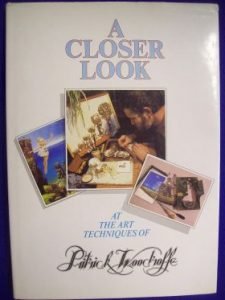A Closer Look At The Art Techniques Of Patrick Woodroffe (book review).
Another book I’ve been meaning to read is ‘A Closer Look At The Art Techniques Of Patrick Woodroffe,’ which I purchased a few years ago. As Woodroffe comments in the introduction, the book is less about showing you how to do his technique but more to show how he did his work in the pre-digital age in 1986. Woodroffe passed away in 2014 after 73 years of life, but he illustrated a number of books, mostly fantasy. Looking at his art, I have to confess it’s extremely stylised, but there’s a certain beauty to it as well.
I raised an eyebrow at the length of his pencil nibs, noting that he was using really hard HB pencils, a technique that is acquired. The sentiment he expressed, that rough work often yields better results than precise work, is a common observation made by artists and one I still need to address. Finding the right lines again is a major challenge, and without the use of an art projector like Neal Adams or a lightbox, it can be challenging to recreate the same feeling in lines twice. At least these days, it’s possible to scan a sketch to work on, and, provided you have the right A3 equipment, do the necessary enlargement if you aren’t going digital. One day, A3 printers will be able to print onto canvas. It’s understandable why artists often favor quick sketches on high-quality paper over notepads, just in case they need to use them.
The expected shift occurs when Woodroffe talks about his copper etching and printing of limited editions. Given the weight of his press and the complaints he made about his house’s floorboards, it’s unlikely that many genre artists would have considered it more than a hobby. Of course, this was more than 40 years ago, and the advent of digital technology has completely transformed the process of creating art today.
It’s interesting how he describes his mixed media and the problems of not being able to use oils for book cover deadlines because of the drying times. You would think that after all these years, a company would have developed a way for oils to rival acrylics in terms of drying times. Despite Woodroffe’s claim that this isn’t a book about teaching techniques, he devotes a significant amount of time to them, some of which I doubt are even used today. You certainly get a variety of names for different techniques.
The final chapter shows Woodroffe’s work with tomography. Essentially, this technique involves creating elements of a picture using cutouts and separating them from the background. To avoid background shadows, the photography must be awkward, and this is a similar technique to back and front projection on television. In many ways, digital painting accomplishes this through layering, a process that is now possible in 3D. I’m sure there’s something to learn and apply from this.
Overall, this 1986 book has a lot more to offer, showing a variety of techniques that are likely to be forgotten in the decades to come, let alone kept in practice. As artists, we never stop leaning, so if you can pick up a copy of this book, you might well find it rewarding.
GF Willmetts
July 2024
(pub: Dragon’s World/Paper Tiger, 1986. 127 page large illustrated softcover. Price: varies. ISBN: 1-85028-024-X)


